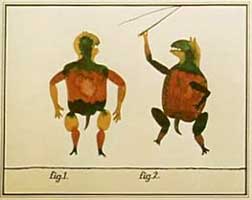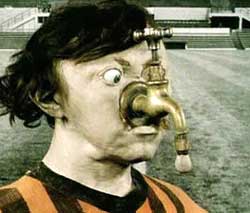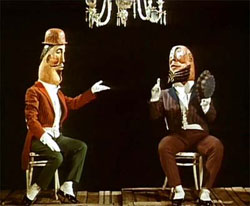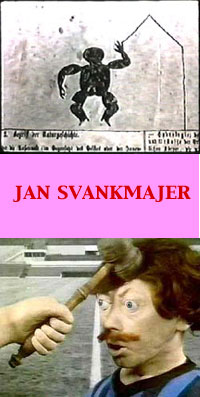 At nearly seven & a half minutes, Et Cetera (1966) would almost qualify as a major early work for animator Jan Svankmajer.
At nearly seven & a half minutes, Et Cetera (1966) would almost qualify as a major early work for animator Jan Svankmajer.
It begins with "drawn" or at least rubber-stamped animation of a human figure attaching wings to itself so it can fly from chair to chair. The successful fellow begins testing different sorts of wings to increasing degrees of functionality, always returning to one of the chairs to perch.
This is followed by an episode of a wild animal tamer with whip forcing a strange creature to do tricks. A third chapter has a human figure with a pencil drawing new bits of environment to interact with, apparently wishing for a house but having sundry disappointments & do-overs.
The color & animation are refined & beautiful in each of the interior three chapters. In the end, the film catches fire & melts.
 Arriving home with plenty of beer & snacks, our hero makes himself a quick dinner while waiting for the Virile Games (1988) to start on television. Arriving home with plenty of beer & snacks, our hero makes himself a quick dinner while waiting for the Virile Games (1988) to start on television.
It starts out almost as a realistic straightforward story of a game being plaid, but soon the soccer match has turned into crazy animation.
A face is mashed like a hunk of clay. An eyeball is sucked out of a head with a splunger. Players move in unison as though skating across the field. Dead players are nailed into coffins & the coffins continue to play soccer.
Hideously disfiguring stuff continues to happen & slain players continue to be nailed in coffins. It all becomes increasingly surreal & maximumly grotesque, though the silliness is rather reptitious & the film, though short at a quarter-hour, is too long by half.
Just when another minute of disfiguring virility seems like it'd put the viewer to sleep, the soccer ball is kicked completely out of the stadium & goes through the window of the chap at home who has been watching the game on the telly. Now things get interesting!
Players arrive at his apartment chasing the ball, & continue to disfigure each other & be hauled off in coffins. But our viewer keeps watching the game on television, even though he could easily turn his head & watch it in his apartment.
There's a final tacky visual joke & when all was said & done I found this one merely juvenile without the authentic wit I expect of Svankmajer. Still, if you look hard, you can see some social commentary about our addiction to violent games & to television & the supplanting of the life around us with what we only observe through the boob tube.
 The last Trick of Mr. Schwarcewallde & Mr. Edgar (1964) has the broken grubby beauty that causes me to be fully aware of Svankmajer as being, at his best, a visual arts genius, as well as a brilliant satirist far exceeding surrealism for the sake of surrealism.
The last Trick of Mr. Schwarcewallde & Mr. Edgar (1964) has the broken grubby beauty that causes me to be fully aware of Svankmajer as being, at his best, a visual arts genius, as well as a brilliant satirist far exceeding surrealism for the sake of surrealism.
The bizarre puppetry is shocking in its diseased beauty. The two puppets are magicians of considerable talents. Opening the top of his head to reveal the clockworks, Mr. Edgar puts a fish in his head, closes himself back up, then turning handle in his ear, opens his head anew, & takes out fish bones.
Everyone claps, & now it is Mr. Schwarcewallde's turn to do a trick. He opens his face, revealing a violin, which he removes, as Mr. Edgar stuffs cotton in his ears so as not to have to listen.
Mr. Schwarcewallde plays an awful tune which induces a number of random objects to begin moving & shape themselves into a dancing horse. Mr. Edgar then reveals that he has numerous arms & begins to play numerous instruments simultanteously.
Mr. S.'s second trick begins with the revelaton that his head has more heads inside it, & he begins juggling his heads. Mr. E. responds by drawing a lion tamer's switch out of his ear & forces the chairs to do tricks.
About then the music gets stuck on a couple of notes, & the magicians begin each to rip off the limbs of his rival. What lucious horrors! This hapens to be one of Svankmajer's great short works.
copyright © by Paghat the Ratgirl
|



